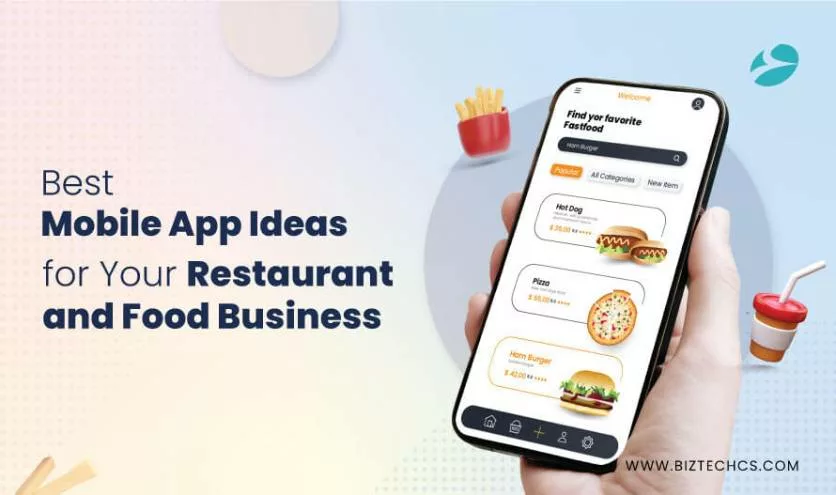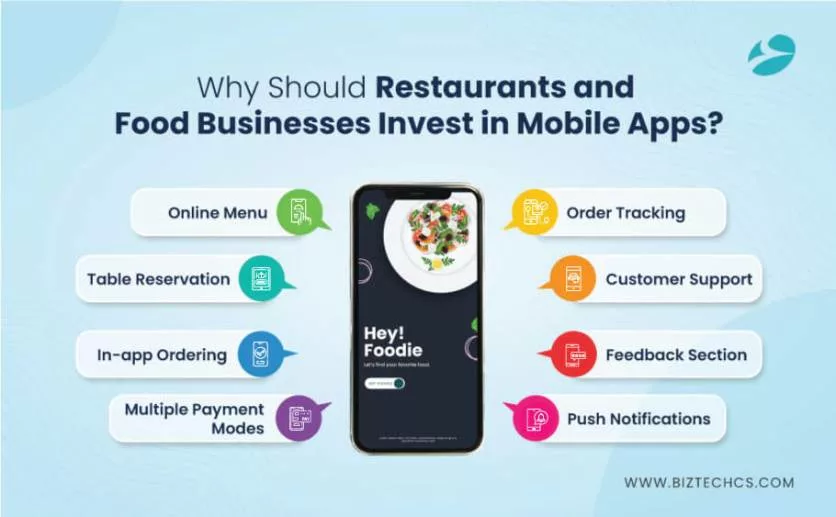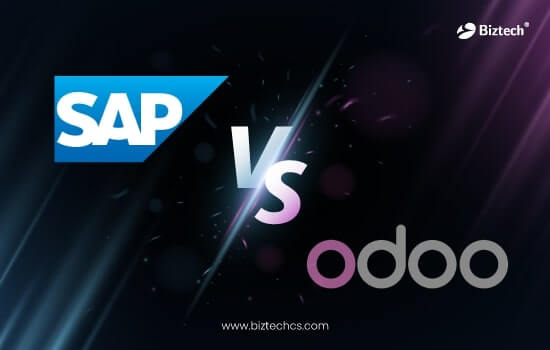43753
Best Mobile App Ideas for Your Restaurant and Food Business in 2025
06 Mar, 2025
10 min read
43753
06 Mar, 2025
10 min read
Table of Content

In today’s digital age, mobile apps have become integral to almost every industry. The food service industry, including restaurants and food businesses, is no exception. With the increasing digitization of our daily lives, restaurants and food businesses must adapt and embrace mobile app technology to stay relevant in a highly competitive market.
For instance, have you checked the tremendous popularity of food applications like Zomato and Swiggy?
Whether delivering food to your customers’ doorstep or enabling your audience to book a table, mobile apps can quickly help improve your customer experience. And with the right mobile app ideas, you can create unique and dominating mobile applications for your audience.
You may as well hire dedicated developers for technical assistance in this pursuit. With the right talent by your side, you can add interesting features like
Want to leverage the mobile technology for your restaurant and food business in 2025 to its best? These mobile app ideas for your food business should come in handy.
But before we explore the varied ideas, let’s help you understand ‘Do you need a mobile app?’.

Today, mobile apps have become a necessity for restaurants and food businesses. They offer many benefits and advantages, making them a crucial investment.
First and foremost, mobile apps expand customer reach. With most people owning smartphones, having a mobile app allows businesses to tap into a market with broader audience. It enables them to showcase their menu items, promote discounts and coupons, and attract potential customers who may not have discovered them otherwise.
Customers can conveniently browse online restaurant menu templates anytime and anywhere without connecting with the restaurant or visiting the outlet. Customers can easily browse through the food options, select their favorite dishes, and place an order with just a few taps on their screens. This convenience saves time for both the customers and the restaurant staff, resulting in increased operational efficiency and customer satisfaction.
Does your restaurant take table reservations? Then, a mobile app for a restaurant may be quite helpful for you. Customers can easily book a table or more depending on the number of people visiting. Your restaurant can also accept bookings or close ongoing bookings and cater to a wider audience segment.
In-app ordering enhances the user experience by offering convenience, speed, and a user-friendly interface. It can include features such as adding items to the cart, specifying dietary preferences, selecting delivery or pickup options, making payments securely, and receiving order confirmation.
This feature is particularly valuable for restaurants and food businesses as it facilitates direct customer engagement and streamlines the ordering process, contributing to increased sales and customer satisfaction.
With a mobile app for a restaurant, you can enable your customers to pay at their convenience. Ensure your mobile app accepts various payment options such as credit and debit cards, UPI payments, cash on delivery, shopping coupons like Sodexo, etc.
Before food delivery startups explored this unexplored territory, people used to bring takeouts or call the restaurant for delivery. However, there was no way to track the food orders in real-time. But with apps for restaurants, your customers can easily track when they should receive an order, whether the food is being prepared, picked up by the delivery executive, or on the way.
With the map integration feature, they can also track the location of the delivery executive in real-time. Thereby, you get to improve customer experience and earn more loyal customers.
The feedback or review section helps understand more about a restaurant’s food style and reputation. Your customers can check out the reviews for honest pros and cons and even get recommendations for the bestselling dishes.
Whenever there’s a discount or offer, your customers are immediately notified of this news through push notifications. This feature was even missing on a website! It also reminds customers of dishes or food items in their carts. Therefore, you have the option to reduce your cart abandonment rate as well.
It is much easier for customers to contact you with their queries and grievances and seek resolution. Make sure your mobile app has a distinguished support section that makes it easier for customers to reach out to you, should they face any issue in the process.
Mobile apps foster customer loyalty. Through features like personalized recommendations, loyalty programs, and push notifications, restaurants can engage with their customers more personally.
This fosters a sense of connection and encourages repeat business, ultimately leading to customer loyalty.
Furthermore, the post-covid era has seen a significant increase in the demand for mobile meal delivery. Having a mobile app allows restaurants to adapt to this changing landscape and offer online food delivery services. Establishing a solid digital presence has become more important than ever for food brands to survive and thrive in the current market.
With the increasing demand for online food delivery services and the need for customer loyalty, there’s much to do in this sector. Have you pondered the various ideas that can help skyrocket your restaurant business sales and customer loyalty?
If not, now’s the time! Check out this comprehensive list of top 10 mobile app ideas for restaurant and food businesses.
Food delivery app development helps create a user-friendly app that allows customers to browse menu items, place orders, and track their delivery in real time. Extending food ordering services can expand your restaurant’s sales and attract more customers.
Examples: Zomato, Uber Eats, Doordash, Domino’s, Just Eat, Swiggy, Faasos
App Development Cost:
Challenges with Food Ordering App Development:
Exclusive New Features for Food Ordering App:
An app that lets customers reserve tables, select time slots, and pre-order their food to reduce waiting time.
Examples: OpenTable, Yelp, Wisely, Table Agent, Eveve, Resy, Eat App
App Development Cost:
Challenges with Table Reservation App Development:
Exclusive New Features for Table Reservation App:
An app that offers exclusive food coupons & discounts for customers to avail while placing orders.
Examples: Ibotta
App Development Cost: $10,000 – $40,000
Challenges with Food Coupon & Discounts App Development:
Exclusive New Features for Food Coupon & Discounts App:
A Grocery Delivery App is a mobile application that enables users to order groceries, organic foods, dairy products, and essential household items from local grocery stores and deliver them to their doorstep. These grocery booking apps provide a convenient and efficient way for customers to shop for groceries without physically visiting a store.
Examples: Fresh, Dunzo, Big Basket, Instacart, Shipt, Peapod, BlinkIt
App Development Cost:
Challenges with Grocery Delivery App Development:
Exclusive New Features for Grocery Delivery App:
A Virtual Cooking Classes App is a mobile application that lets users learn cooking skills, techniques, and recipes through virtual lessons and tutorials. This app allows users to participate in cooking classes from the comfort of their homes, providing a convenient and interactive way to enhance their culinary skills.
Examples: Top Chef University, Masterclass, Home Cooking New York
App Development Cost:
Challenges with Virtual Cooking Classes App Development:
Exclusive New Features for Virtual Cooking Classes App:
An app that connects restaurants or food makers with potential customers who want to purchase surplus or leftover food at discounted prices to reduce food wastage.
Examples: FoodCloud, Karma, Nowaste, Kitche, Nosh, Olio, Too Good To Go
App Development Cost:
Challenges with Food Waste Reduction App Development:
Exclusive New Features for Food Waste Reduction App:
An app that offers personalized diet plans and recommends food items based on the customer’s health goals, preferences, and fitness requirements.
Example: MyFitnessPal, Ate Food Journal, Noom, PlateJoy MyPlate Calorie Counter
App Development Cost: $50,000 to $200,000
Challenges with Personalized Diet App Development:
Exclusive New Features for Personalized Diet App:
A Restaurant POS (Point of Sale) App is a software application designed to facilitate and streamline various operations within a restaurant, including order processing, payment handling, inventory management, and customer interactions. It serves as a central hub where servers, kitchen staff, and management can access and manage all aspects of the restaurant’s operations from a digital device, typically a tablet or smartphone.
Examples: Square POS, NCR Aloha, Talech, Lightspeed Restaurant, Toast
App Development Cost:
Challenges with Restaurant POS App Development:
Exclusive New Features for Restaurant POS App:
Incorporate a self-order kiosk within the app, allowing customers to browse the menu, select items, customize orders, and place them directly from their smartphones. This reduces waiting time and minimizes errors in order taking.
These ideas for food apps cater to the diverse needs of the food service industry, enhancing customer satisfaction, and reducing operational costs. By incorporating these restaurant app ideas you can build the best apps for restaurant owners and food business owners.
Partnering with a reliable mobile app development company will further help restaurant owners bring innovative food delivery app ideas to life and thrive in the competitive food app industry.
Around one-third of all food produced globally goes to waste, leading to massive financial and environmental losses. In 2025, restaurants and food businesses can leverage a food wastage reduction app to track, manage, and repurpose surplus food efficiently. These apps can analyze inventory, predict demand, and connect businesses with donation centers or discount platforms.
Features like AI-driven stock monitoring, real-time alerts, and integration with food banks can help minimize waste.
With sustainability becoming a priority, such apps can reduce costs, boost brand image, and support zero-waste initiatives in the food industry.
Examples: Too Good To Go, Olio, Karma, Food Rescue US, NoWaste
Food Wastage Reduction App Development Cost:
Challenges with Food Wastage Reduction App Development:
Exclusive New Features for Food Wastage Reduction App:
Successful restaurant and food business apps have become a game-changer for the food industry. The best restaurant apps for owners enhance customer engagement, streamline operations, and boost revenue.
Clearly, it’s a win-win for both entrepreneurs and customers!
Now that you have explored the various AI mobile app ideas, it is time to take inspiration from some top restaurant and food business apps that have garnered immense success.
OpenTable is a popular app that allows users to make restaurant reservations effortlessly. Features like real-time availability, time slots, and user reviews have significantly improved customer satisfaction and streamlined reservation management for restaurant owners.
UberEats has revolutionized the food delivery industry by offering a convenient platform for ordering food from various outlets. This app gives customers access to a wide range of food menu items, discounts, and delivery options, boosting customer loyalty and expanding the potential customer base for food businesses.
Foodpanda is a leading online food delivery app that works seamlessly with multiple restaurants. Its user-friendly interface, diverse food options, and prompt delivery services have helped food businesses increase their reach and operational efficiency.
This app addresses the issue of food waste by providing a platform for leftover food from restaurants and food outlets to be purchased at discounted rates. It not only benefits potential customers who demand food at lower prices but also reduces the wastage of delicious food.
Although not a traditional restaurant app, MyFitnessPal has gained popularity among fitness freaks. It has become a useful tool for analyzing food items and promoting healthy eating habits by allowing users to track their calorie intake and nutritional content.
Zomato is the best delivery app to work for millions of users. The renowned food delivery app has revolutionized the way people order food. With its user-friendly interface and extensive restaurant listings, Zomato has become a household name in the food delivery industry.
The app’s success can be attributed to its seamless ordering process, real-time tracking, and diverse cuisine options that cater to a wide range of tastes and preferences. Zomato’s commitment to delivering quality food, coupled with its reliable delivery service, has earned the trust of millions of users worldwide. The app’s success story includes strategic restaurant partnerships, efficient logistics, and innovative features like personalized recommendations and reviews.
These successful restaurant and food business apps inspire entrepreneurs looking to enter the industry or improve their existing ventures. By understanding the target audience’s needs and collaborating with experienced mobile app developers, businesses can create compelling digital solutions to enhance customer engagement, streamline operations, and boost revenue.
Mobile app ideas for restaurant and food businesses are crucial for staying competitive and catering to customer needs. With the help of this blog post, we have tried to highlight the significance of these ideas in addressing various aspects of the food industry, such as food wastage, online food delivery services, customer loyalty, and managing operational costs.
You achieve success in the competitive food service industry by checking out these mobile app ideas to make money and earn loyal customers.
Do you want to drive customer satisfaction, attract new customers, and establish your brand in the highly competitive space? Then, our mobile app developers can help you greatly. We are a renowned mobile app development company with 16+ years of experience in various industries.
With our top-vetted talent, we can help you build restaurant and food business apps unique to your brand. Connect with us today with your idea!
To develop a restaurant app, define its purpose and features like online ordering, reservations, and payments. Choose a platform, design a user-friendly interface, integrate key functionalities, test thoroughly, and improve based on user feedback.
Apps with online ordering and delivery services are highly in demand. Features like table booking, contactless payment, and loyalty rewards also attract customers by enhancing convenience and engagement.
Yes, mobile apps boost sales by offering a direct and convenient way for customers to order. Features like push notifications, personalized promotions, and loyalty programs encourage repeat business and increase revenue.
Food delivery apps make money through commissions, delivery fees, and subscriptions. With a growing customer base and effective marketing, they can be highly profitable in the long run.
A basic food delivery app costs around $10,000–$20,000, while advanced apps with tracking and payment integrations range from $25,000–$50,000 or more. The final cost depends on features, design, and development team rates.

Odoo
7558
By Biztech
04 Jul, 2025
Odoo
209
By Devik Gondaliya
02 Jul, 2025

Odoo
486
By Devik Gondaliya
25 Jun, 2025